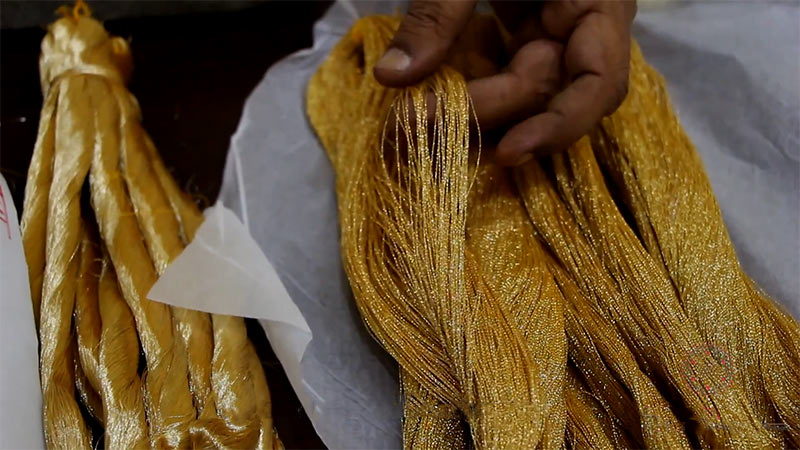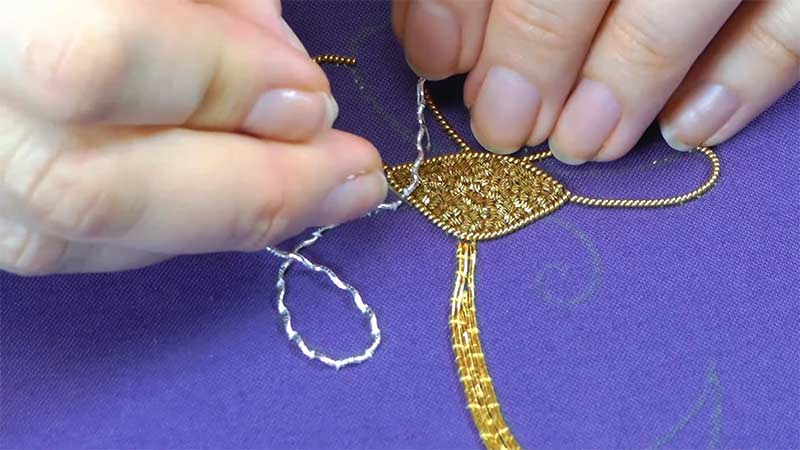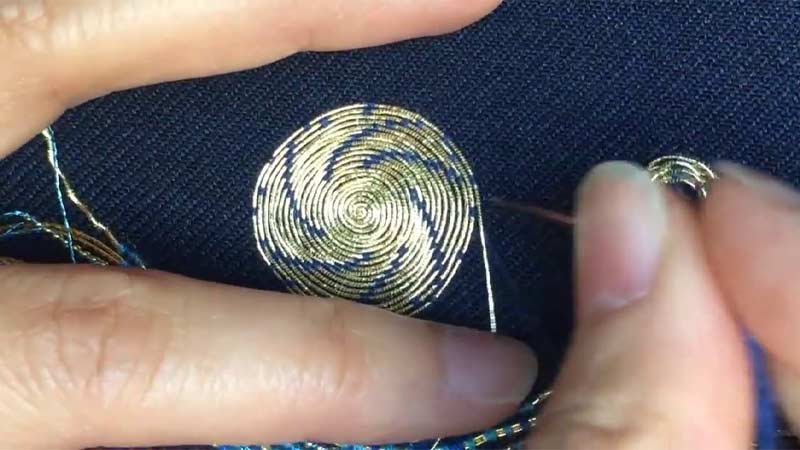Embarking on a journey through luxurious textiles, one question often echoes in curious minds – what is a gold-threaded fabric called? The answer lies in the exquisite intersection of craftsmanship and luxury.
This golden thread, interwoven with fabrics, has graced the attire of royalty and adorned ceremonial garments for centuries.
Join us as we unravel the mystique surrounding this regal material, exploring its history, cultural significance, and the meticulous techniques employed in its creation. We’ll explore its applications and infusion processes.
From the shimmering allure of brocades to the timeless elegance of metallic embroidery, discover the various forms in which gold-threaded fabric manifests, capturing the essence of splendor and tradition.
Let the gleaming threads guide us into a world where textiles become more than just garments—they become expressions of artistry and a testament to the enduring allure of gold.

What Is Gold-Threaded Fabric Called?
Gold thread is known as the “cloth of gold,” which has its roots in medieval Europe, where fabrics interwoven with gold and silk threads became synonymous with luxury and royalty.
These opulent textiles adorned the attire of kings, queens, and nobility, symbolizing wealth and power. The shimmering effect created by the interplay of gold threads with various base fabrics such as silk or wool added a regal touch to garments.
Expansion Around the World
Beyond Europe, civilizations across Asia also embraced the art of weaving gold into fabric. In India, for instance, zari work involves using metallic threads, including gold, to embellish textiles.
The intricate craftsmanship of zari is often seen in traditional garments like saris and lehengas, showcasing a fusion of heritage and elegance.
The Craftsmanship Behind Gold-Threaded Fabrics
Creating gold-threaded fabric requires a meticulous and skilled approach. Pure gold or gold-coated silver threads are delicately woven into the fabric using brocading, embroidery, or weaving techniques.
The choice of weaving method and the design’s intricacy contribute to the fabric’s final aesthetic appeal.
Brocading involves adding supplementary weft threads to create intricate patterns. This technique allows for the formation of raised motifs, enhancing the texture and visual appeal of the fabric.
Embroidery, however, entails stitching gold threads onto the fabric’s surface, creating detailed and ornate designs.
Cultural Significance
Gold-threaded fabric transcends its material essence; it carries profound cultural significance and symbolism. In many cultures, gold is considered a symbol of prosperity, purity, and divine connection.
Incorporating gold thread into garments elevates them beyond mere clothing, transforming them into symbols of status, ritual, and celebration.
Religious Symbolism
In religious ceremonies, garments made from gold-threaded fabric are often worn to signify the sacredness of the occasion. Whether in the form of priestly vestments or ceremonial robes, gold threads impart a sense of reverence and grandeur.
Evolution and Adaptation in Contemporary Fashion
While gold-threaded fabric has deep roots in history, it continues to evolve and adapt to contemporary fashion trends. Designers worldwide embrace the timeless allure of gold, incorporating it into modern clothing and accessories.
From haute couture runways to bridal ensembles, gold thread fabric continues to captivate with its radiance and sophistication.
Innovations in technology have also played a role in the modern resurgence of gold fabric. Metallic threads, often made with a combination of synthetic materials and metallic coatings, provide a more accessible alternative to pure gold threads.
The Allure of Fabric with Gold Threads in Global Fashion
The fascination with gold-threaded fabric extends beyond regional boundaries, finding a global appeal in the fashion industry.
Designers draw inspiration from diverse cultural traditions, infusing their creations with the luxurious touch of gold threads. Whether adorning bridal gowns, evening wear, or accessories, gold-threaded fabrics continue to symbolize elegance and sophistication.
Uses of Gold-Threaded Fabrics

From traditional ceremonies to contemporary fashion, the shimmering allure of gold-threaded fabrics has stood the test of time. Let’s explore 10 captivating uses that showcase these luxurious textiles’ versatility and enduring appeal.
Royal Attire and Ceremonial Garments
Gold-threaded fabrics have a long history of adorning the attire of royalty and dignitaries. Kings, queens, and nobility have worn garments woven with real gold or gold-coated threads during ceremonial events, symbolizing wealth, power, and regality.
Religious and Ritualistic Garments
Across different cultures and religions, gold-threaded fabrics hold significant importance in creating religious attire. Priestly vestments, ceremonial robes, and sacred textiles often incorporate gold threads to enhance the visual splendor and convey a sense of reverence.
Traditional Ethnic Wear
Gold-threaded fabrics play a pivotal role in traditional ethnic wear around the world. From Indian saris adorned with intricate zari work to Middle Eastern garments featuring metallic embroidery, these textiles enrich the cultural heritage of diverse communities.
Bridal Ensembles
The allure of gold-threaded fabrics is evident in bridal fashion, which adds glamour and richness to wedding ensembles. Bridal gowns, lehengas, and veils often feature gold threads, creating a timeless and luxurious bridal aesthetic.
Haute Couture and Designer Fashion
Renowned fashion designers leverage the elegance of gold-threaded fabrics to create haute couture pieces. Runway shows often showcase elaborate gowns, suits, and accessories that incorporate gold threads, elevating the designs to the pinnacle of luxury and style.
Home Furnishings and Decor
Beyond attire, gold-threaded fabrics extend their allure to home furnishings. Luxurious drapes, upholstery, and decorative textiles infused with gold threads bring a sense of luxury to interior spaces, transforming homes into elegant sanctuaries.
Ceremonial Flags and Banners
The grandeur of gold-threaded fabrics is not limited to clothing; it extends to ceremonial flags and banners.
In various cultures, flags used in processions, religious ceremonies, and official events often feature gold embroidery or woven threads, adding a regal touch to the symbolism.
Costume Design for Theater and Film
Costume designers in the entertainment industry appreciate the visual impact of gold-threaded fabrics. Whether creating period pieces or fantasy costumes, incorporating gold threads enhances characters’ authenticity and visual appeal on stage and screen.
Luxury Accessories
Gold-threaded fabrics find their way into luxury accessories, enriching the design of handbags, scarves, and footwear. The subtle glimmer of gold threads adds a touch of sophistication to accessories, making them coveted elements in high-end fashion.
Contemporary Everyday Fashion
Embracing the spirit of fusion and modernity, gold-threaded fabrics have transcended traditional boundaries. Contemporary designers infuse everyday fashion with the elegance of gold threads, creating a seamless blend of cultural richness and modern style in casual wear.
How to Infuse Gold Thread in Fabric?

Infusing gold thread into fabric requires precision and attention to detail. Here is a step-by-step guide on how to incorporate gold thread into fabric using various techniques:
Selecting the Fabric
Choose a fabric that complements the intended use and design. Silk, satin, and velvet are popular choices for their ability to showcase the shimmering qualities of gold thread.
Choosing the Gold Thread
Decide whether to use actual gold or metallic threads with a gold coating. Actual gold thread adds authenticity but can be expensive, while metallic threads provide a more affordable alternative without compromising aesthetics.
Preparation of the Fabric
Ensure the fabric is clean and well-prepared for the embroidery process. Iron the fabric to remove any wrinkles and use stabilizers to reinforce delicate fabrics if necessary.
Thread Selection
Choose the appropriate thickness and type of gold thread based on the desired effect. Thicker threads may create a bold and prominent look, while finer threads can be used for delicate embroidery.
Embroidery Technique
Introduce gold threads during the weaving process to create intricate patterns. Another way is to stitch gold threads directly onto the fabric using satin, couching, or chain stitch.
Design Planning
Sketch or plan the design on the fabric before starting the embroidery. This helps maintain symmetry and ensures the gold thread is seamlessly incorporated into the overall pattern.
Securing the Gold Thread
Use appropriate knots or stitches to secure the gold thread to the fabric. This is crucial to prevent unraveling and maintain the longevity of the embroidery.
Maintaining Tension
Maintain consistent tension on the gold thread while embroidering to ensure an even and polished appearance. Uneven tension can lead to irregularities in the pattern.
Experimenting with Patterns
Explore different patterns and motifs to enhance the visual appeal of the fabric. Geometric shapes, floral designs, and intricate borders are common choices for gold-threaded fabrics.
Finishing Touches
Once the embroidery is complete, carefully inspect the fabric for any loose threads or imperfections. Trim excess thread and, if necessary, press the fabric again to set the stitches and achieve a smooth finish.
FAQs
What is Gold-Threaded Fabric Called?
Gold-threaded fabric is often referred to as “cloth of gold.” This term encompasses textiles woven with real gold or gold-coated threads, showcasing a luxurious and opulent aesthetic.
How is Gold Thread Incorporated into Fabric?
Gold thread can be infused into fabric through various techniques, including brocading during the weaving process, surface embroidery using stitches like satin or chain stitch, and traditional methods like zari work, where metallic threads, including gold, are woven into the fabric.
What Fabrics Work Best with Gold Thread?
Fabrics like silk, satin, and velvet are commonly chosen for their ability to complement the shimmering qualities of gold thread. The selection depends on the intended use and design preferences.
Is Real Gold Used in Gold-Threaded Fabrics?
Yes, real gold is often used in the creation of gold-threaded fabrics. However, due to cost considerations, metallic threads with a gold coating are also commonly employed to achieve a similar aesthetic without the expense of using pure gold.
Where Can Gold-Threaded Fabrics Be Applied?
Gold-threaded fabrics find versatile applications, including royal and ceremonial attire, religious and ritualistic garments, traditional ethnic wear, bridal ensembles, haute fashion, home furnishings, ceremonial flags and banners, costume design for theater and film, luxury accessories, and contemporary everyday fashion.
Conclusion
In concluding our exploration of the glorious world of gold-threaded fabric, we find ourselves enchanted by the timeless allure woven into each delicate strand. Beyond its grandeur, this material carries heritage, prestige, and artistic mastery stories.
As we navigate the intricate tapestry of history, it becomes clear that the nameless golden threads that adorn fabrics are not just embellishments but symbols of culture, affluence, and the human pursuit of beauty.
Whether gracing ceremonial robes or enhancing contemporary fashion, gold-threaded fabric transcends its practical purpose, becoming a living testament to craftsmanship and elegance.
So, the next time you encounter this spectacle, remember that it’s more than just a textile it’s a shimmering thread that binds together the threads of tradition, luxury, and the enduring legacy of gold in fashion and beyond.
Leave a Reply